Few animals instill quite the same fear as sharks. As apex predators many types of sharks are well equipped to inflict serious injury; large, fast, powerful and armed with row upon row of razor sharp teeth these fish are finely honed killing machines. Yet with around 400 shark species it is only a tiny minority that present any danger to humans. I would regard only three, possibly four, of all the species as “man-eating sharks“. In this article we will look at the weaponry and statistics to determine which are the most dangerous sharks in the world.
After sifting through the shark attack records held by the International Shark Attack File (ISAF) and the Global Shark Attack File (GSAF) it is clear that only a few species habitually attack people and that many of the other shark species need provoking before they will bite.
Statistically it is incredibly rare for any species of shark to attack, but when they do the results can be so horrific that it is burnt into the popular psyche. Reports of victims bitten in two or half eaten by sharks the size of a school bus are always going to be at the back of many people’s minds as they dip their toe in the ocean.
Onto the list. Unlike many lists that just rank the sharks purely on the statistics, I have looked at the potential to do damage, aggression and habitats of the sharks to decide which pose the biggest threat to humans.
10. Hammerhead Shark

The hammerhead sharks are actually a family of sharks (Sphyrnidae) which range in size from less than a metre (3ft) to over 6 metres (20ft). It is believed the strangely shaped head allows the shark better all round vision. To most observers the different species are difficult to tell apart, especially when they’re biting your foot off. It does seem likely though that it is the great hammerhead shark (Sphyrna mokarran) which are the most likely candidates. Reaching a whopping 6+ metres (20ft), weighing up to 600kg (1,300 lb) and equipped with teeth similar to those of the bull shark there is no doubt the great hammerhead could easily inflict deadly injuries on a human. It is also suggested that these may be more aggressive than other hammerhead species.
As a group the hammerheads have been involved in 34 attacks over the years, one of which was fatal. Whether this number reflects their potential danger is uncertain as they are an endangered species.
9. Blacktip Shark
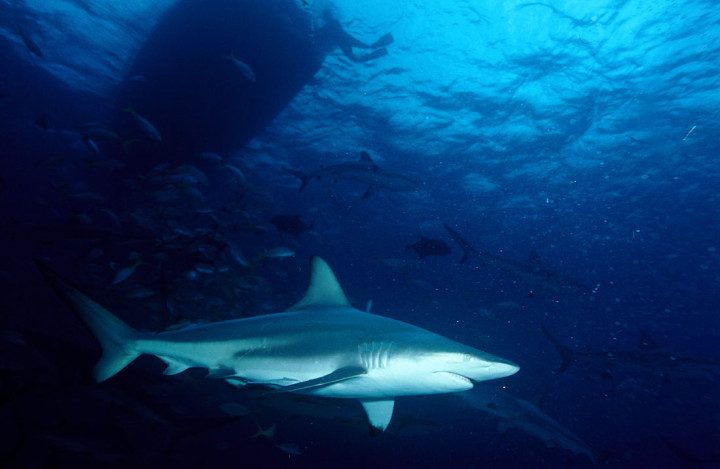
The blacktip shark (Carcharhinus limbatus) is both common and widely distributed throughout the tropical /subtropical shallows of the world. It gets its name from the black tips and fringes to its fins and tail. Generally blacktips are fairly small measuring less than 5ft (1.6m), however bigger specimens can reach up to 9ft (2.8m) and weigh over 100kg (220lb). What they lack in size they make up for in energy, often being seen leaping out of the water when chasing fish.
Blacktip sharks are not generally regarded as being very dangerous to humans owing to their size. But they are frequent attackers, making up the highest percentage of shark attacks in Florida. The ISAF has 41 attacks by blacktip sharks on record, one of which was fatal.
8. Sand Tiger Shark
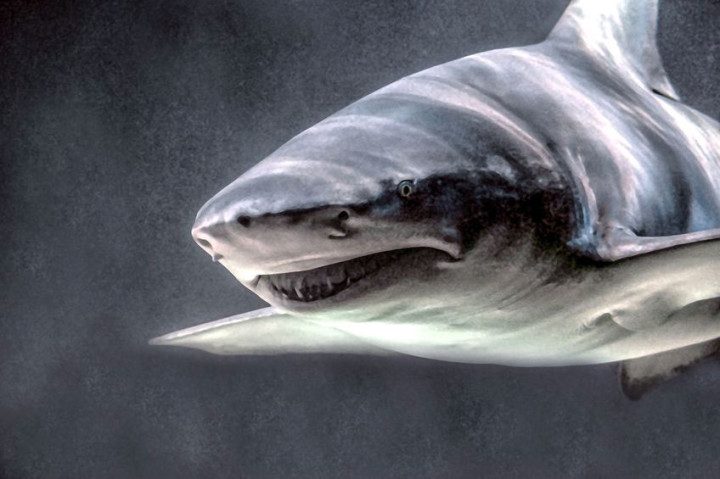
Many people are familiar with the sand tiger (Carcharias taurus) as the large sharks you see when visiting an aquarium. They go by a number of names including grey nurse shark, ragged-tooth shark and blue-nurse sand tiger and are found in warm waters around the world.
The sand tiger shark grows to around 3.2 metres (11ft) in length and can weigh up to 160kg (350 lbs). However, it is the ferocious looking teeth that tend to get people’s attention. There are three rows of long, sharp, pointy teeth which menacingly protrude from the sharks mouth. Despite looking terrifying, the teeth are designed for grasping small slippery prey such as fish and squid.
Sand tiger sharks probably have a worse reputation than they deserve. The fact they are called ‘tigers’ and frequently roam the surfline putting them into contact with humans does not help their cause. In reality they are not tigers at all and relatively docile. That said they have been known to attack and they have been responsible for two deaths. Many of the attacks seem to have involved spear-fishing where the shark has gone for the catch. There have also been a couple of incidents with people bitten in aquariums.
7. Blue shark
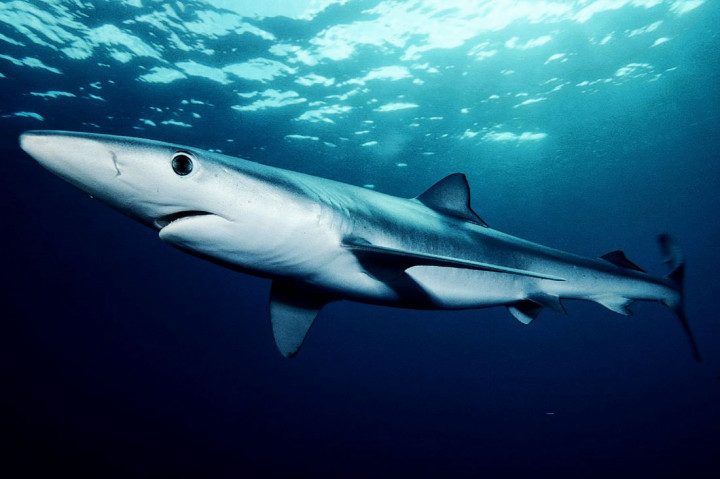
Another member of the requiem shark family, the Blue Shark (Prionace glauca) is one of the most widespread and common sharks. It can be found as far north as Norway and as far south as Chile, yet being a deep water species it rarely come into contact with people. This streamlined shark is capable of bursts of speed which it uses for chasing down its prey of squid and fish. The largest specimens recorded are over 12 ft (3.8m), but there have been unconfirmed reports of up to 21 feet.
In the wild the blue shark has few natural predators although it is said killer whales will take them. Larger sharks may also prey on small blue sharks, this was illustrated in 1969 at Sea World in San Diego where captive blue sharks were mixed in with bull sharks. Suffice to say the bull sharks thrived…
In terms of danger the odds a firmly stacked in humans favour. Between 10 and 20 million sharks are killed a year through fishing. On the other hand the blue shark is considered potentially dangerous and has been responsible for fatal attacks. Some were the result of the shark being landed in a fishing boat but others occurred on shipwrecked sailors in the open ocean. The blue shark is known to circle swimmers and divers for up to 15 minutes and it may be more inclined to take a bit in such situations.
6. Bronze Whaler Shark
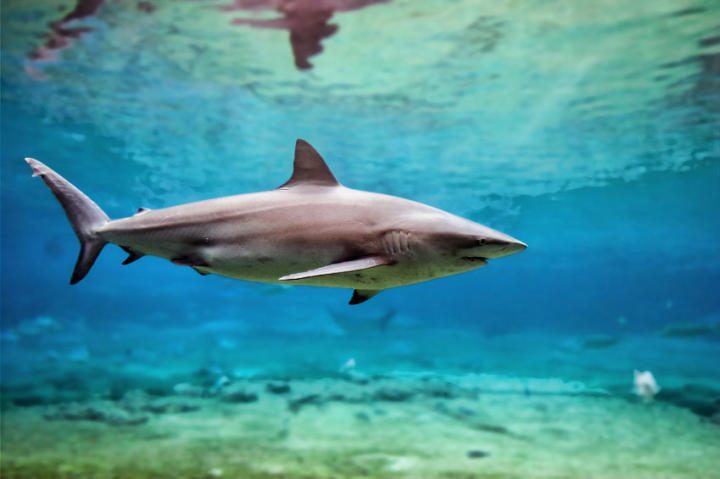
The bronze whaler or copper shark (Carcharhinus brachyurus) gets its name from its colouring and the fact that this and other sharks would congregate at the sites of whale kills in the days of whaling. It is common in war, but not tropical waters around the world where it spends its time in shallow bays, harbours and estuary mouths. The species is at its most prominent during the annual sardine run in South Africa where it will gorge on the fish in groups exhibiting feeding frenzy behaviour.
The bronze whaler is a large shark reaching over 10ft (3m) in length and weighing around 675 lbs (300kg). It is a fast powerful swimmer equipped with long serrated teeth. With its size and dentition the whaler does pose a threat to humans and has been implicated in quite a few attacks. It isn’t generally aggressive towards humans but it has been known to harass spear fishermen. There have also been a number of unprovoked attacks on swimmers and surfers along the east coast of Australia including being implicated in at least two attacks that proved fatal.
5. Shortfin Mako
The shortfin mako shark (Isurus oxyrinchus), or blue pointer, is a member of the mackerel shark family (Lamnidae). This family contains such illustrious members as the great white shark and prehistoric megalodon. It isn’t a big surprise then to find the mako shark on this list.
The warm-blooded mako can grow to a fair size. Adults usually measure around 10ft (3m) but the biggest mako sharks can measure around 15ft (4.5m) and weigh in at nearly a ton. Combined with its size the mako has an incredible turn of speed. This shark has been recorded at up to 46 mph (74km/h) and some scientists suggest it can go much faster. With this speed the mako shark can make incredible leaps out of the water. One problem is that this often lands them in the middle of a fishing boat and they have been known to inflict severe injuries out of the water.
Makos have been responsible for three recorded deaths and have a reputation for aggression.
4. Oceanic Whitetip
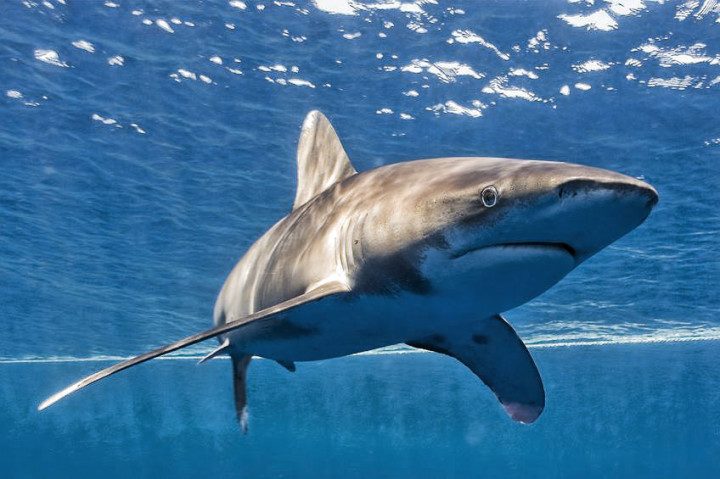
The oceanic whitetip shark (Carcharhinus longimanus) is the first of the sharks on this list I would genuinely classify as a “man-eater”. It has almost definitely killed more people than all the other sharks put together. The reason it is not at the top of the list is the vast majority of these attacks were completely opportunistic and the result of air and sea disasters. There were several incidents of ships being sunk during World War II in which it is believed sharks were responsible for hundreds of deaths, with the prime attacker being the whitetip.
Whilst slow moving and lethargic the oceanic whitetip can be incredibly aggressive and persistent. They are known to engage in feeding frenzy behaviour and their attitude is to take whatever is available rather than avoid a fight and wait for the next opportunity. It is for these reasons Jacques Cousteau referred to them as “the most dangerous of all sharks”. The whitetip is a capable killer with powerful jaws, bold nature and often large size – the biggest specimen recorded was 4 metres (13ft)
As well as a attacking in the open ocean the whitetip has been implicated in a number of fatal attacks on swimmers and divers including a series of notorious attacks in the Red Sea in 2010 which left one woman dead.
3. Tiger Shark
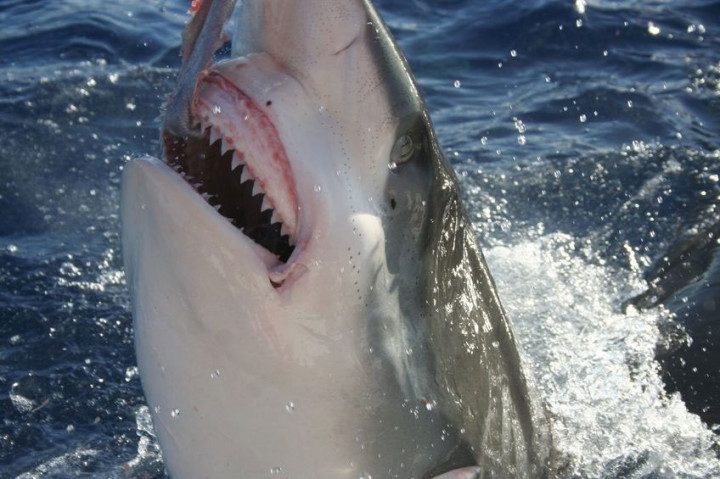
The tiger shark (Galeocerdo cuvier) is big, common and aggressive. The name comes from both its temperament and the stripes running down its sides. It is also known as “the garbage can of the sea” as it commonly swallows anythings it comes across. Objects recovered from tiger sharks’ stomachs include bottles, tires, clothes, cats, pigs and even a whole horse head. You get the picture! More common prey include fish, seals, dolphins, birds and turtles.
The tiger shark can be found in coastal tropical and sub-tropical waters around the world although they tend to stay in water deeper than 20 feet (6m). Tigers are the fourth biggest of all sharks with large specimens reaching well over 16ft (5m) and weighing over a ton. It really is a bit of a bruiser with its heavy build and incredibly thick skin (8 times thicker than cowhide). They also have a proportionately wider mouth than other sharks. This prodigious mouth is lined with serrated teeth which are perfect for slicing prey, as opposed to gripping like many of the sharks above.
Obviously humans are no match for a shark with these attributes and the tiger shark has a well earned reputation as a maneater. It is without doubt the most dangerous shark in the tropics and accounts for the majority of attacks in Australia and Hawaii. The statistics speak for themselves, the number of fatalities is second only to the great white shark and the death rate from attacks is high.
2. Bull Shark
The bull shark (Carcharhinus leucas) is considered to be the most dangerous shark of all by many. However, it doesn’t seem to have acquired quite the reputation of the great white and tiger sharks. There are several reasons why this shark is considered particularly dangerous including its physical attributes.
Bulls also go by more names than most sharks, which is indication of its range and distribution. These include the Ganges shark, Nicaragua shark, river shark, Swan River Whaler, shovelnose, bull whaler, Fitzroy Creek whaler, square-nose, and Van Rooyen’s shark.
The bull shark is a large powerful shark, measuring up to 11.5 feet (3.5m) in length and up to 700lbs (318 kg) in weight. It gets its name from its flat snout and stocky build along with its pugnacious nature. It comes well equipped in the jaws department too with several rows of triangular, serrated teeth ideal for slicing through prey. Highly territorial this shark will attack other species that it feels threaten its territory and that includes humans.
What makes bull sharks particularly dangerous to humans is the likelihood of crossing paths with one of these brutes is higher than with any other of the dangerous sharks. Not only does the bull shark live in shallow coastal waters it can do something most other sharks cannot – tolerate fresh water. The sharks specially adapted kidneys allow it to travel thousands of miles up rivers and even live in lakes. Not happy with merely being able to swim up the rivers of the world the bull shark has also claimed many victims in freshwater.
Ranked third by number of attacks in the ISAF records it is believed that many of the bull sharks attacks go unreported as they occur in the third world. There have been 104 recorded attacks of which a third were fatal.
1. Great White Shark
Just the name Great White Shark is enough to send people running from the beach. Already notorious the Jaws movies of the 1970s further demonised this shark (if that was necessary?!) and consolidated its reputation as a man eater. Carcharodon carcharias is though, without doubt, one of planet Earth’s ultimate killing machines.
The biggest great white specimens are around 6.5 metres (22ft) in length. However, several reports of sharks as big as 8 metres (26ft) and weighing nearly 3.5 tons have been published. Set between crushingly powerful jaws are rows of triangular teeth around 3 inches long which are serrated along either side. These are used to slice up the prey which the shark does by shaking its head from side to side. If a tooth is broken one from the row behind takes its place.
This shark is no slouch either. When heading in for the kill the great white can accelerate to 35 mph (56 km/h). Combined with its bulk this is like being hit by a freight train and will stun or even kill the prey. With usual prey animals such as sea lions and seals humans stand practically no chance against this beast.
Great whites actually have no interest in eating humans, nowhere near enough flesh, and it seems most attacks are mistaken identity or the shark just being inquisitive. Unfortunately a 3 ton shark giving an inquisitive nibble can involve the loss of an arm or a leg.
These sharks occur in all the oceans of the world and tolerate water temperatures between 12 and 24°C (54 and 75 °F). They can be found in deep water or near the coast, generally around seal colonies. Great whites are most concentrated around the shores of South Africa, Australia, Northeast USA, California, Japan and the Mediterranean. That last one surprises a lot of people, especially as there have been over 30 recorded attacks in the Med.
Without doubt the great white is the most dangerous of all sharks and the statistics back this up with over 400 attacks recorded worldwide of which many were fatal. Ironically, it is the great white that needs protecting from man and with numbers on the decline it is a protected species in many countries.
To end this article I thought I’d share this video that shows another side to the great white shark. Here we see Ocean Ramsey free diving with what is regarded as one of the most dangerous animals on the planet.



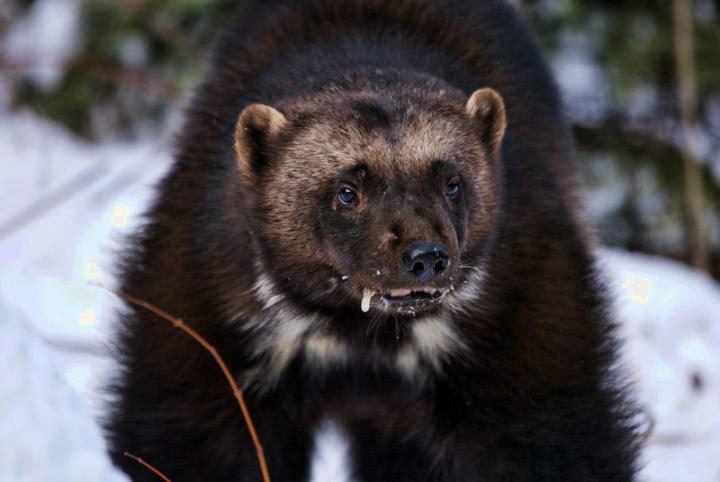
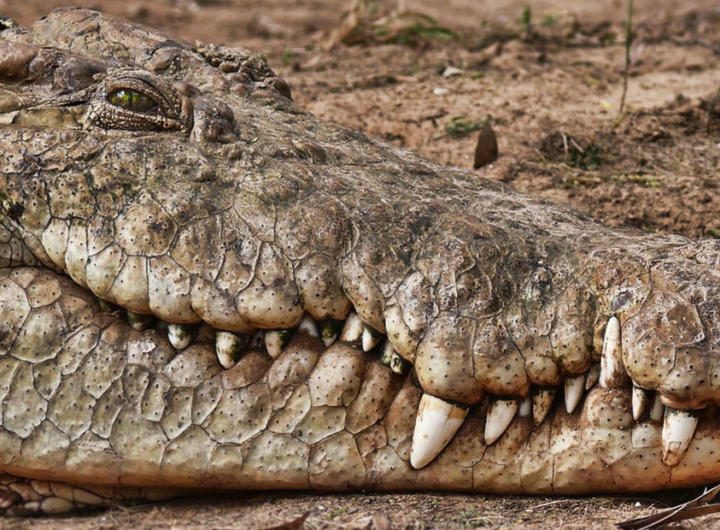

I watched Jaws in theaters when I was 12-13, I spent the next 3 years in the school library researching them…learned that sharks are cool and they kill for food cause of instinct and not for fun like humans……dont eat sharks and dont buy china based shark products………they are cool and many generations should enjoy seeing them living free in the world!!!
I know they’re dangerous but they’re also just gorgeous. Ancient, graceful, beautiful. These are living dinosaurs, folks!
Hm. The Sharks are one of the most feared species in the world, when in reality they are probably the ones who shouldn’t be feared. Shark attacks only happen because mindless idiots go through places where the shark is, disturbing their natural habitat. They should be studied more often, and this is just putting more fear into people. And several of these facts are untrue, including about the Great White being the most powerful.
Great white sharks are pussy fish. Sharks are pussy fish in general. Ohhhh… I will go eat a baby seal. Killer whales have driven great whites off the Farrilons after they killed one. A giant squid would probably rip a great white shark to pieces with little trouble. Jaws was nonsense. Great whites rarely get over 15 feet much less than 20. 25?? never recorded. Great white sharks and sharks and general are pussy fish. Humans own them. And we will continue to own and dominate the pussy fish because they were born to be killed and eaten by us.
Wow this dude got some issues, btw, great white sharks can’t live in cage, they die for some reason. Have you ever seen a great white shark in seaworld or anything like that? no? how come can humans then own a shark, who cant live in a cage?
Call it a pussy fish just because movies have overrated the shark, but i bet you won’t when you,re diving right in front of it.
Imagine if humans didn’t have such technology, good luck fighting a shark by hand, but then again, we’re intelligent, and shouldn’t abuse the animals there isn’t.
Eat as much shark as you wan’t to, dumbass.
Yea, some people just don’t respect nature…
You respond to a tongue&cheek post as if it were serious with
personal comments and you think I have issues? Jeez. Hello pot meet
kettle. But just staying in character. The great white shark is a
pussy fish. Beats up on baby sea lions either because it is too slow
or too stupid to catch the adults!! 😉 F***** shark is a pussy
fish… not even in the top 5 in the ocean. 5 ocean dwelling critters
that could kill f***** pussy great white sharks: 1) orcas, 2) sperm
whales, 3) giant squid, 4) box jellyfish, 5) collasial squid. Maybes
include the greenland shark, 6 gill shark, tiger shark, and false
killer whale. F****** great white is probably not even in the top 10.
If one met a cone snail on the wrong day it would go crawling home to
mommy! 😉 See ya pot.
I only approved this post so the rest of the World could see how much of an idiot you are…
I have never seen a post so stupid, I had to make a list of corrections, but whatever.
1. The expression is tongue in cheek
2. You have serious issues
3. What is wrong with you? If there was a cooked steak in front of you, and a live cow outside, would you try to attack and eat the cow outside? Of course not. If the shark tried to catch harder prey instead of easy prey, it would be retarded. And sharks do catch the adults from time to time…
4. A pussy fish? are you kidding me? See my above comment on your first retarded post
5. Gill sharks, tiger sharks, and false killer whales are all about the same size as a great white, but the great white is more aggressive and has a much greater bite force. You tell me, who would win?
6. A cone snail kill a 20-foot shark? Are you serious? Cone snail would just run away and hide under coral (it has a limited amount of strikes with its poison harpoon, so it will save it for prey).
7. Sharks don’t live with their mothers.
8. Be respectful of nature, or one day it will bite your face off.
There is not a single squid or octopus in the ocean that would survive an attack from a great white.
Yes, octopi eat smaller sharks, but even a teenage great white would kill a colossal squid with no effort.
You know colossal squid is like 55 feet long right
You know that a giant squid is on average three times bigger than the biggest great white shark, right.
Damn you are real stupid huh? Killer whales making GW run away? Wtf Great Whites have driven them to fear over the years as they swim faster bulky enough to stun or kill if they hit one on the right spot, they’re teeth are one of the sharpest if not the sharpest in the world, combine that with their really strong bite force it will tear chunks from the KW.
You should watch the Shark Week programs showing Orcas predating White Shark livers. Large GW carcasses started showing up on the shores of South African beaches with their livers “surgically” removed. It was a puzzle until Orcas were actually seen hunting and predating on GW.
Orcas are the undoubtable pinnacle of ocean predators. The same thing has happened in the Farrallon Islands in CA to the point that when Orcas show up, the GW population goes away.
Wow really? I don’t think you would be feeling the same if a short fin mako or open ocean white was coming at you at 40mph with a wide mouth full of buzzsaw teeth. Rember we go into their habitat they are the top dog there. We don’t own or rule a damned thing in the ocean. We can only hide on big steel ships and use tech to kill them. In a fair fight come as you are it’s no contest. Sharks are the most
important creature in our oceans. Often called the garbagemen off the sea. They actually help keep our oceans clean,and other aquatic species healthy.
I agree I think that sharks are one of the most misunderstood creatures in the world. GWs aren’t that bad. We are just idiots for invading theyre space. We will destroy the ocean when we haven’t even see 5% of it
So just because a shark can be killed by other animals and it goes after easy prey it is a “pussy fish”? You would get trampled by an elephant and you eat food that is already dead, so do you consider yourself a “pussy mammal”? Also, Jaws is fictional. Do you also criticize Star Wars because The Force doesn’t exist?
Using that word is degrading to women. Please stop.
Could you please show the evidence for the single Hammerhead fatality?
http://www.sharkattackfile.net/spreadsheets/pdf_directory/1963.00.00.a-Seychelles.pdf
Lots of them. Check out “Myth and the Maneater” David Kenyon Webster. Several fatalities. Off California and North Carolina beaches. I have surfed all US Coasts. I had a 12 inch Hammerhead swimming around us off figure eight in North Carolina. I was more concerned about where Mommy was hiding.
Greatest number of Shark attacks in the world is Volusia County Florida. Fortunately most are sandsharks but they are everywhere. Off Smyrna Beach on Summer mornings you can see hundreds of sharks clearing their gills and converging just beyond the break. Biggest Shark I ever saw was an Australian Gray nurse. Winter Surf with feathering offshore breeze, crystal clear lovely winter day in Australia. This sure put the damper on the day. This is main reason for Australian caged beaches. Funny thing is the gray nurse in Coastal USA is a very docile fish. The Australian is very aggressive.
Great white has attacked 400+ people and you are saying that they AREN’T dangerous?!
Be interesting to know the numbers of each shark in existence, but it looks like Great White is the deadliest as its quite rare yet has killed the shit out of many poor humans.
true that!
Meh, either you do something stupid, leak blood into the water, or hurt one severely and that is the only time a shark will attack you. Any shark is deadly, but they aren’t going to kill you because they see you, smell you or hear you….
HEY! I do that alot and NO sharks get ME!
The Great White is not the most deadly shark in the world. The Bull Shark is, in fact, considered the most deadly by most experts. Though the Great White has been involved in a number of attacks, many being fatal, the Bull Shark is most deadly due to it’s ability to survive in fresh water and it’s aggression. Bull Sharks have more testosterone (even the females of this species) than a male elephant in the mating season, which obviously makes them extremely aggressive and territorial.
Most experts will tell you that the Bull is the most deadly of all the sharks. Many Bull Shark attacks are blamed on Great Whites so, in reality, Bull Sharks have probably attacked just as many, if not more, humans than Great Whites.
Agreed. And I think most of the points you made are included above.
However, I went with the great white for three reasons: 1. It wins out statistically. 2. It is a more powerful, better armed killing machine. And 3. it just looks much scarier!
“It just looks scarier”?? Are you serious??
The chances of you surviving a bull shark attack are much greater than a great white. Although Bull sharks have more availability and more likely to attack, you have a decent chance to survive, especially since their attacks are usually in shallow water so they’re easier to see while in the area.
GWS attacks are in the deep sea where they usually attack from underneath. Combined with their far greater physical power than a bull shark, you’re guaranteed to die unless the GWS decides to spare your life.
YES FINALLY SOME ONE UNDERSTANDS!
ok if u want to belive that go ahead I’m not gonna stop you.
yeah…
The article said that. But given many of Bull Shark attacks go unrecorded one can’t possibly put any shark above the white shark. Look at those statistics..
Actually most recent data shows virtually every great white attack and or death was the result of either accidental bites while the shark was eating other prey or “taste” bites and the shark left. GW sharks have never full on attacked and eaten a human deliberately, ever in history that has been verified and proven reliably. Several others like the bull and mako have been documented as deliberate and have even been photographed or filmed doing so. The GW shark is highly misunderstood and villanized mainly due to an overrated 70s horror film and it’s unfortunate name association.
Says that in the article. But at the end of the day, accidental or not, GWs still kill the most people…
No they don’t, most attacks attributed to Great White Sharks were far more likely to have been by Bull Sharks, including the 1916 Jersey Shore attacks. Great White sharks don’t eat humans, however Bull Sharks do eat humans.
How do you know the last hundred years of shark attack data is wrong? Do you have a source?
Because it has been constantly pointed out that for the last hundred years The Great White was blamed for shark attacks simply because it was the most vicious looking one. Most of those White Tip Kills? They used to be labeled as Great White kills until more studies showed that behavioral odds point towards the White Tip and not the Great White. As researchers learn animalistic traits/behavior habits they eventually can change previous assumptions based on it not matching the characteristics of the animal.
Great Whites for example have almost NEVER deliberately attacked a human.
That is true, but i believe they are refering to other prey and not humans
You are correct to an extent. The bull shark hunts in groups, and that is how they are effective at killing. Although, great white sharks hunt in singulars, and by themselves are much mare dangerous then a bull shark is alone.
I’d rather get caught in the water with a great white over a mako, Tiger, or Bull shark any day though. that Great White I just have to hope has recently eaten, the other 3 will most likely attack even if they have.
But, if a bull or a mako attack you, they’ll flee after realizing you taste like crap and from all your hitting.
By the time a great white realizes you taste like crap, both of your legs are already missing.
hey at lest its second
jaws is actually a bull shark not a Great White
But if a bull shark attacks you, you can hit it and have a chance to survive.
Against a far larger great white, you can die instantly.
Too humans yes, because they are really close to shore, a human could survive a bull shark attack, but a nibble from a GW are low, yes B.S. have a stronger bite force, but their teeth are no where sharp or close compared to the GW, GW are sharks with really good bite force and with the most sharpest teeth in the world, if they fought GW would obviously win, they swim so fast and are bulky at the same time, most deadly combination on a animal especially a shark they can literally paralyze or even kill their opponent with just that and just imagine it coming super fast ready to stab you, it would tear you apart with its sharp teeth, making it the most deadly animal in the world and not only that, but it’s extremely intelligent.
I did not know there a lot of the most biggest sharks
And there are a lot of Great White Sharks
Not too many – they are a protected species. Also you only find them in certain places.